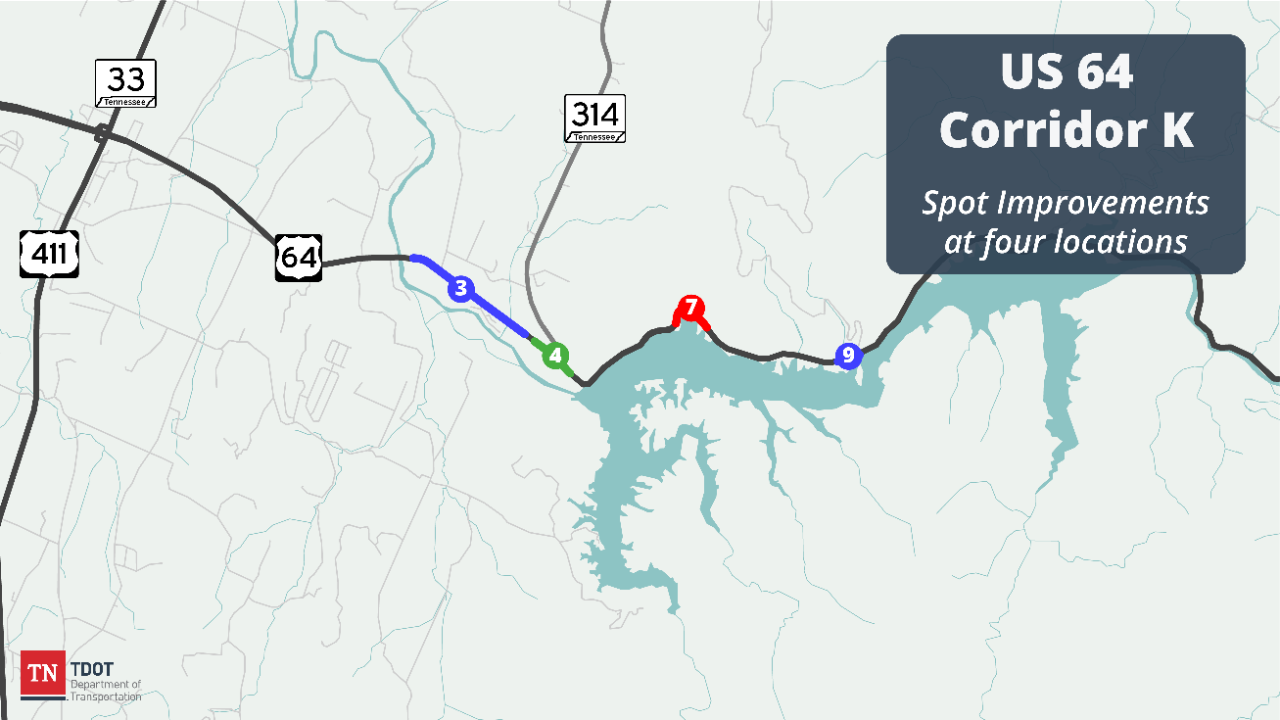US 64 (Corridor K)
Polk County
A series of projects have been identified for US 64, commonly referred to as Corridor K. The proposed spot improvements would cover approximately 20 miles of the corridor, from west of the Ocoee River to State Route (SR) 68 near Ducktown. The purpose of the proposed projects is to improve the safety and efficiency of the route, as well as regional mobility and connectivity. The improvements would preserve environmental quality and support economic development.
Proposed design improvements include roadway widening, guardrail installation, and curve correction, as well as intersection and recreational access improvements. Proposed rockfall mitigation includes rock excavation and catch fence installation. Due to the size of the proposed improvements, TDOT has split the project into several segments.
Four spot improvements are in TDOT's 10-Year Project Plan, with construction scheduled for Fiscal Year 2027. Concepts for the remainder of the corridor will continue to be developed and added to the plan.
Current Status: TDOT is currently working with the Appalachian Regional Commission (ARC) on a targeted approach. Four targeted approach locations have been identified and are currently in preliminary engineering and environmental studies are scheduled on locations to the east.
Estimated construction start: Fiscal Year 2027
Estimated completion: TBD
| Polk County |
|
|---|---|
| Location 3: Welcome Valley Road to the bridge over Cloud Branch |
Add a center two-way turning lane, six-foot paved shoulders, a 10-foot shared use path, and replace the bridge over Cloud Branch. |
| Location 4: Bridge over Cloud Branch to east of SR 314 |
Add a center two-way turning lane, six-foot paved shoulders, a 10-foot shared use path, and replace the bridge over Cloud Branch. |
| Location 7: Near the Lake Ocoee Inn to near the Lake Ocoee Marina | Improve the horizontal curve on SR 40 to improve the design speed, add a new entrance to Lake Ocoee Docks and Fuel (including a right-turn lane), and add a westbound left-turn lane. |
| Location 9: Existing USFS Ranger Station access drive to Oswald Road |
Widen SR 40 to provide improved access to the Cherokee National Forest Ranger Station and Chilhowee Recreation area, including a dedicated left-turn lane onto Oswald Road. |

History and Background
Corridor K is part of the Appalachian Development Highway System (ADHS), which stretches 127 miles between Cleveland, Tennessee, and Dillsboro, North Carolina. The section of Corridor K, known as the Ocoee River Gorge section, includes 20 miles of US 64 between the Ocoee River and Ducktown.
The Ocoee River Gorge section of Corridor K is part of the Ocoee Scenic Byway and is a Tennessee Scenic Parkway. It is also the only east-west arterial in the region and serves through, local, and recreational traffic.
The existing two-lane highway does not meet current design standards. The corridor contains numerous roadway deficiencies and safety issues with limited shoulder widths, lack of guardrails, inadequate sight distance, and sharp curves. The windy, rocky terrain also presents a major barrier to development with increased susceptibility to rockslides and lack of convenient detours.
However, funding and environmental challenges have stymied development efforts along Corridor K. TDOT's current approach is to identify targeted spot improvements to improve safety and mobility along the corridor. Four segments are currently identified for funding.

Public Involvement and Engagement
The Tennessee Department of Transportation (TDOT) will host one informational public meeting on Tuesday, September 30, 2025, to gather public input on the US 64 Project, known as the Corridor K. The purpose of the proposed projects is to improve the safety and efficiency of the route, as well as regional mobility and connectivity. The meeting will be held from 5 to 7 p.m. Eastern time at the following location:
September 30, 2025
Shiloh Baptist Church
358 US 64 Highway, Ocoee, TN 37361
The meeting will be held to provide the public with an opportunity to provide comments regarding this proposed Project. Representatives from TDOT and the project team will be available to provide information on various aspects of this proposed Project. Anyone with questions regarding the meeting should contact:
Michael O’Donnell, PE
Phone: (423) 634-8622
Michael.Odonnell@tn.gov
Persons with a disability, who require aids or services to participate at the meeting, may contact Ms. Shanna Chevalier no less than ten (10) days prior to the date of the meeting:
Ms. Shanna M. Chevalier, ADA Coordinator
505 Deaderick Street, Suite 1200
Nashville, TN 37243
TDOT.ADACompliance@tn.gov
Phone: (615) 741-0465
TTY Relay 711
Comment cards will be available for those who prefer to make written statements at the public meeting. Written statements and other exhibits to be included in the project transcript may be submitted within twenty-one (21) days after the final meeting date to the following address:
Project Comments
Tennessee Department of Transportation
Suite 700, James K. Polk Building
505 Deaderick Street
Nashville, TN 37243-0332
This website will be one of the principal means of public involvement and feedback. Public comments concerning this project can also be submitted to: TDOT.Comments@tn.gov.
TDOT is an Equal Opportunity Employer and does not discriminate on the basis of race, age, sex, religion, color, disability, or national origin. In the event of inclement weather that results in the closure of city and county schools, the meeting will be postponed.
Previous Public Meeting Materials
TDOT hosted a public information meeting on September 10, 2024, to gather public input on the proposed Corridor K Targeted Approach projects in Polk County. The meeting was held at Shiloh Baptist Church located at 358 US 64 in Ocoee.
September 10, 2024, Corridor K Public Meeting Presentation

Project Imagery and Visuals

Environment
Feasibility studies and environmental reviews will be conducted for all proposed improvements to Corridor K. Environmental studies will be coordinated with state and federal agencies and conducted during the National Environmental Policy Act (NEPA) document development process.
Environmental Documents were completed as D-List Categorical Exclusion for Locations 3 and 4 in June 2025.
Project Contacts
Rae Anne Bradley
TDOT Region 2 Regional Communications Officer (media)
Phone: (423) 510-1164
Email: Rae-Anne.Bradley@tn.gov
Michael O’Donnell, P.E.
Region 2 Project Management Director
Phone: (423) 634-8622
Email: Michael.Odonnell@tn.gov
*Subject to change